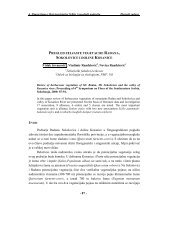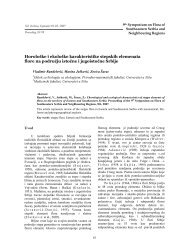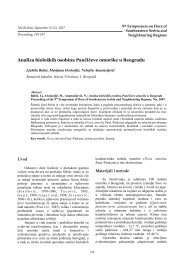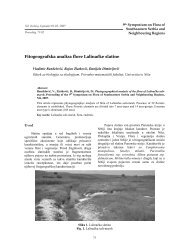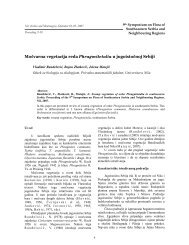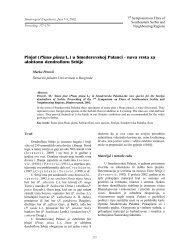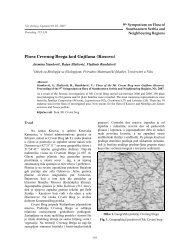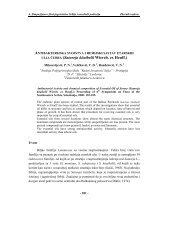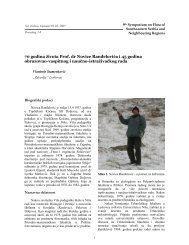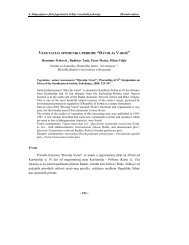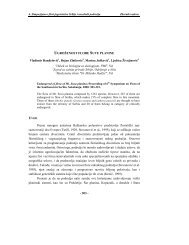10th Symposium on the Flora of Southeastern Serbia and ...
10th Symposium on the Flora of Southeastern Serbia and ...
10th Symposium on the Flora of Southeastern Serbia and ...
You also want an ePaper? Increase the reach of your titles
YUMPU automatically turns print PDFs into web optimized ePapers that Google loves.
10 th <str<strong>on</strong>g>Symposium</str<strong>on</strong>g> <strong>on</strong> <strong>the</strong> <strong>Flora</strong> <strong>of</strong> Sou<strong>the</strong>astern <strong>Serbia</strong> <strong>and</strong> Neighbouring regi<strong>on</strong>s,Vlasina 17 to 20 June 2010Antimikrobna aktivnost metanolnih ekstrakata odabranihvrsta lišajeva familije ParmeliaceaeStojanović, I. 1 , Radulović, N. 2 , Jovanović, O. 2 , Petrović, G. 2 , Stojanović, G. 21 Department <strong>of</strong> Pharmacy, Faculty <strong>of</strong> Medicine, University <strong>of</strong> Nis, <strong>Serbia</strong>2 Department <strong>of</strong> Chemistry, Faculty <strong>of</strong> Natural Sciences <strong>and</strong> Ma<strong>the</strong>matics,University <strong>of</strong> Nis, <strong>Serbia</strong>igor.pfc@hotmail.comLichens have been used in folk medicine as astringents, t<strong>on</strong>ics <strong>and</strong> forpulm<strong>on</strong>ary disease. Scientific researches justified antibiotic, antiviral, antitumor,analgesic, <strong>and</strong> antipyretic properties <strong>of</strong> lichen’s extracts. In this work <strong>the</strong>antimicrobial activity <strong>of</strong> methanol extracts <strong>of</strong> four Parmeliaceae species:Hypogymnia physodes (L.) Nyl., Evernia prunastri (L.) Ach., Flavoparmeliacaperata (L.) Hale <strong>and</strong> Parmelia sulcata Taylor were determined. Material <strong>and</strong>methods: Extracts were prepared by extracti<strong>on</strong> <strong>of</strong> dry <strong>and</strong> ground lichens withmethanol <strong>on</strong> ambient temperature without exposure to direct sunlight (24 h). Theantimicrobial assay were performed using <strong>the</strong> disc diffusi<strong>on</strong> technique placing 40 μL<strong>of</strong> methanol soluti<strong>on</strong> <strong>of</strong> extract c<strong>on</strong>centrati<strong>on</strong> <strong>of</strong> 25mg/mL <strong>on</strong> discs (12.7 mmdiameter). Followed microorganisms were used: Gram pozitive bacteria(Enterococus sp, B. subtilllis, Sarcina lutea, Micrococus flavus, S. aureus, Cl.piogeneus ), Gram negative bacteria (E. coli, P. vulgaris, S. enteritidis, P.aeruginosa, K. pneum<strong>on</strong>ie) <strong>and</strong> fungi (A. niger <strong>and</strong> C. albicans). Results:Aglomerative cluster analysis (AHC) <strong>of</strong> obtained results can be summarized in <strong>the</strong>following : • H. physodes <strong>and</strong> E. prunastri extracts manifested str<strong>on</strong>gest activity(diameter <strong>of</strong> inhibiti<strong>on</strong> z<strong>on</strong>es ranged from 17 to 26 mm) than F. caperata <strong>and</strong> P.sulcata extracts (diameter <strong>of</strong> inhibiti<strong>on</strong> z<strong>on</strong>es ranged from 15 to 22 mm). • Based <strong>on</strong>microorganisms´ susceptibility towards extracts two groups were distinguished: <strong>the</strong>first c<strong>on</strong>sisting <strong>of</strong> Gram negatve bacteria (P. vulgaris <strong>and</strong> K. pneum<strong>on</strong>ie) <strong>and</strong> fungi(A. niger <strong>and</strong> C. albicans) <strong>and</strong> <strong>the</strong> sec<strong>on</strong>d group including all Gram positive bacteria<strong>and</strong> three Gram negative bacteria (E. coli, S. eneritidis <strong>and</strong> P. aeruginosa).C<strong>on</strong>clusi<strong>on</strong>: The examined extracts showed moderate <strong>and</strong> n<strong>on</strong>selective antibacterialactivity a bit lower <strong>the</strong>n activity <strong>of</strong> tetracycline st<strong>and</strong>ard. It is worthy <strong>of</strong> menti<strong>on</strong>ingthat H. physodes <strong>and</strong> E. prunastri extracts inhibited A. niger <strong>and</strong> C. albicans morethan nistatine st<strong>and</strong>ard which suggests <strong>the</strong>ir possible use as active ingredients inphyto-<strong>the</strong>rapeutics.98



